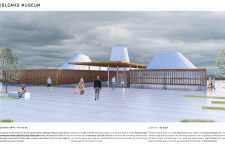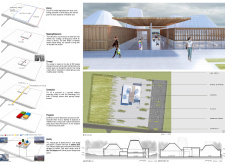5 key facts about this project
The architectural concept emphasizes the tectonic dynamics between the North American and Eurasian plates. A central boulevard serves as a metaphorical rift, guiding visitors through the museum while providing a tangible connection to the geological themes represented. The spatial organization enhances the visitor experience by promoting exploration throughout the museum and fostering interaction among guests.
Unique Architectural Features
The design incorporates a distinctive roof structure composed of four conical forms, each symbolizing one of Iceland's prominent volcanoes: Eyjafjallajökull, Katla, Hekla, and Hvannadalshnjúkur. These conical roofs are not purely aesthetic; they create varying interior scales and light conditions, influencing the atmosphere of the exhibition spaces. This correlation between form and narrative is a key aspect of the design, allowing the museum to communicate its themes effectively.
The integration of natural materials, such as wooden facade panels and granite flooring, further connects the building with its surroundings. These materials align with traditional Icelandic architecture while providing durability and a natural warmth to the structure. The use of white polycarbonate panels in the roof allows diffused light to filter into the space, creating a lively yet controlled environment that enhances the exhibition experience.
Spatial Organization and Functionality
The museum features a well-organized layout, with designated areas for exhibitions, educational programming, a café, and administrative offices. The central plaza provides an open space that enhances interaction and facilitates access to various sections of the museum. It connects the parking area with the museum entrance, emphasizing the importance of flow and accessibility in the design.
In addition to its educational function, the museum serves as a community hub, offering a venue for gatherings, workshops, and presentations related to geology and environmental science. This multifunctional aspect is a critical component of the project, aiming to deepen the public’s understanding of Iceland’s natural phenomena.
The Volcano Museum stands out among architectural designs by its thoughtful integration of geological concepts and visitor engagement strategies. The consideration of both form and function exemplifies a modern approach to museum design that prioritizes education while celebrating the unique characteristics of the Icelandic landscape.
For further exploration of the project's architectural plans, architectural sections, and design ideas, interested readers are encouraged to review the detailed presentations available. These elements provide deeper insights into the project's conception and execution, highlighting the thought processes that informed this architectural endeavor.


























